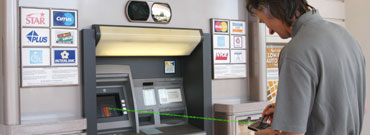 |
» |
|
|  |
 |
| |
Research opportunities |
 |
 |
In today's world, the hard truth about protecting electronic messages and transactions is that no matter how advanced the technology being used, there is no guarantee of absolute security. As quickly as researchers develop ever-more-rigorous methods for keeping private information private, others figure out how to skirt those safeguards.
That's particularly worrisome as our society becomes more and more dependent on e-commerce. Scientists say that even measures now considered virtually 'unbreakable' might someday be broken, by either mathematicians or computers that develop new algorithms to crack the protective code. |
|
|
Our approach |
 |
 |
Although 100 percent-guaranteed security remains elusive (and requires effective processes as much as technology) HP Labs scientists who specialize in cryptography are trying to get close to that goal.
Their efforts are based on a century-old method of secure communication using shared secrets. This method is the only one known to offer a guarantee of security. However, this guarantee relies on the integrity of the shared secrets -- until now, the problem has been how to share these secrets securely.
Help is at hand from the laws of quantum physics, which essentially state that no one can look at a quantum system without changing it, thus leaving evidence that it's been observed.
Quantum technology using this property of nature can now be built to enable secrets, or 'keys,' to be shared between folk with assured integrity. Once the keys exist, they can be used for secure identification, or access, or communication, or financial transactions. |
 |
Research focus |
 |
 |
 |
HP researchers are experimenting with quantum key distribution (QKD), in which quantum signals are sent and then measured; this raw data is then distilled into secure shared keys.
The quantum aspect allows the parties -- whether they're individuals or organizations, such as banks or merchants -- to instantly detect any unauthorized access. Eavesdroppers get nothing but useless bits of irrelevant code. |
 |
 |
 |
Current work |
 |
 |
Quantum keys are distributed via light signals (photons), so their use is currently limited to the maximum distance a weak light beam can travel without amplification or correction, which would corrupt the quantum signal.
Currently this is 100km or so, either down optical fiber or even across free space -- ultimately the goal is to enable secure quantum communication via satellites. So there is now real potential for a secure quantum 'backbone' communication network.
To bring quantum cryptography to consumers, we are developing a low-cost, short-distance version for devices such as personal digital assistants (PDAs) and cell phones. These could then be used for anything from authenticating the device-owner's identity to protecting an electronic transaction at an automatic teller machine.
That effort would be designed to provide both consumers and enterprises with security that still isn't quite perfect -- but closer than it's ever been before. |
 |
Future applications |
 |
 |
Although we expect quantum technology will first appear in secure communications backbones connecting financial institutions, governmental installations and other specialized facilities, we are focused on making the technique practical for everyday tasks such as using an ATM. Eventually, quantum keys could replace passwords or PINs for many common transactions.
|
|
 |
|
Basic research & emerging markets |
 |
|
|
|
